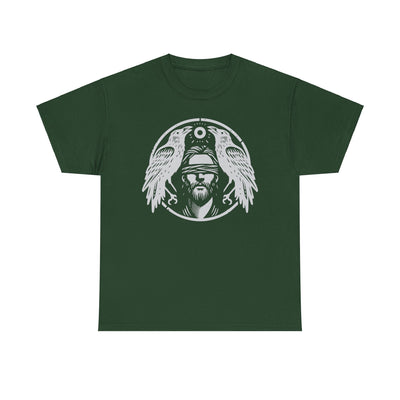Why the Forest of Culture is so Important to the Nordic Peoples
Forests have played a central role in the culture of the Nordic peoples for centuries. They are not only a habitat for numerous animals and plants, but also a source of inspiration, spirituality and identity. Even our ancestors, especially the Germanic peoples, saw the forest as more than just a collection of trees. For them, the forest was a sacred place, a place of refuge and a source of wisdom. But why is the forest so important to us, and what significance does it have for nature, animals and people? Let us delve deeper into the fascinating world of the forest and its significance for culture and the environment.
Introduction to the importance of the forest in Nordic culture
The close connection between people and nature
In the Nordic countries, as in Germany, the forest has always played a fundamental role in culture. People lived in close symbiosis with nature, using its resources and worshipping it at the same time. The forest provided shelter, food and material for daily life, but it was also a mystical place that appeared in myths and legends. Nature was considered a kind of goddess, and the forest was her sacred temple.
The forest as a cultural symbol and spiritual place
The forest is of great spiritual importance, especially in Nordic mythology. Many ancient rituals and traditions took place in the forest. The trees were considered a connection between heaven and earth, and some trees were sacred to people. Many Nordic peoples worshipped trees, and the forest was considered the home of the gods and spirits.
Why is the forest so important to us?
The forest as a source of resources
For centuries, the forest has provided us with the most important raw materials we need for our daily lives: wood for building houses and furniture, food in the form of berries and mushrooms, and medicinal plants that our ancestors already used. The forest is therefore not only a part of our culture, but also a vital resource.
Forest and Health – Peace and Relaxation in Nature
Many people seek peace and relaxation in the forest. It is scientifically proven that a walk in the forest reduces stress, strengthens the immune system and promotes general well-being. In today's hectic world, the forest offers a place of refuge where we can reconnect with nature.
Ecological Importance of Forests for the Climate
In addition to the direct benefits for us humans, forests play a crucial role in the global ecosystem. Forests are true climate regulators: they bind large amounts of CO2, produce oxygen and influence the water cycle. Without forests, our climate would be even more unstable and the effects of climate change even more drastic.
What are the 5 functions of the forest?
Protective function – How the forest protects us from natural hazards
Forests serve as natural protection against erosion and avalanches. The roots of trees stabilize the soil, prevent landslides and help absorb water, which counteracts flooding. Especially in mountainous regions, forests are a vital protective shield against natural hazards.
habitat function – home for flora and fauna
A forest is home to thousands of species - both animals and plants. From insects to birds to mammals, all find a place to live, hunt and breed in the forest. The forest also provides protection for many rare and endangered species that would hardly be able to survive in other habitats.
Utility function – raw materials such as wood and medicinal plants
In addition to its recreational function, the forest also provides valuable raw materials, especially wood. It is used for construction, as fuel and for many other purposes. The forest also provides medicinal plants that have been used in traditional medicine for centuries. Herbs, bark and mushrooms from the forest have healing powers that are increasingly coming into focus again today.
Recreational function – A retreat for the soul
For many people, the forest is a place of relaxation. It offers us the opportunity to escape from everyday life and immerse ourselves in a world of peace and nature. Hikers, nature lovers and families visit forests to breathe fresh air, enjoy the silence and relax.
Climate Function – How Forests Influence the Weather
Forests play an important role in the water cycle and influence the local and global climate. They contribute to the formation of clouds and rain through the evaporation of water from trees and soils. Forests also act as a buffer against extreme weather conditions such as heat and cold.
What significance does the forest have for people and animals?
The forest as a habitat for countless animal species
Forests are home to an amazing variety of animal species, from small insects to large predators. They provide food, shelter and breeding grounds. Many animals are so dependent on the forest that they could not survive without it.
significance for indigenous peoples and traditional societies
For many indigenous peoples, especially in the Nordic countries, the forest is a sacred place. It is not only a habitat, but also a spiritual place. Rituals, stories and traditions are closely linked to the forest, and many of these cultures have learned to live in harmony with nature.
The forest as a source of inspiration for art, literature and mythology
The forest has always inspired artists, writers and musicians. The forest played a central role in Nordic mythology, and in literature and art from the Middle Ages to the present day the forest is a symbol of the unknown, the mystical and the sacred.
Which trees were sacred to the Germanic peoples?
The Oak – A Symbol of Strength and Wisdom
The oak was sacred to the Germanic peoples and was considered a tree of the gods, especially Donar (Thor), the god of thunder. It stood for strength, stability and protection.
The Ash Tree - The World Tree Yggdrasil
In Norse mythology, the ash tree plays a central role as the world tree Yggdrasil . It connects the different levels of the universe and symbolizes the structure of the cosmos.
The Linden Tree – A Place of Gathering and Justice
In many Germanic villages, the linden tree was the tree under which the community gathered to dispense justice. It was considered a tree of love and justice.
Where is the oldest forest in the world?
The Daintree Rainforest in Australia
The oldest existing rainforest in the world is the Daintree Rainforest in Australia. It is over 135 million years old and is home to an incredible variety of plants and animals.
Other important old forests on the world map
In addition to the Daintree, there are many ancient forests around the world, including the Amazon rainforest, the Białowieża Forest in Poland and Belarus, and the Taiga Forest in Russia.
Where is the German forest?
Distribution of Forests in Germany
In Germany, forests cover around a third of the land area. Particularly large forest areas can be found in the south and west of the country.
The Black Forest – A Symbol of German Closeness to Nature
The Black Forest is one of the most famous forest areas in Germany and attracts millions of tourists every year. It is a symbol of German nature and culture.
The Bavarian Forest – Natural Paradise and Primeval Forest
The Bavarian Forest is home to Germany's first national park and offers a glimpse of untouched nature where flora and fauna can flourish freely.
What types of forests are there in Germany?
Deciduous forests – beech and oak forests
Germany is rich in deciduous forests, especially beech and oak forests. These forests shape the landscape and are a habitat for many animal species.
Mixed forests – A mixture of deciduous and coniferous trees
Mixed forests combine the best of both worlds and, thanks to the diversity of tree species, offer ideal conditions for many plant and animal species.
Coniferous forests – pines and spruces in colder regions
In the colder regions and higher elevations of Germany, coniferous forests dominate, especially with spruces and pines, which adapt well to the climatic conditions.
Conclusion – The forest as an irreplaceable part of our culture and future
The forest is more than just a collection of trees. It is a cultural symbol, a place of peace and recreation, a source of raw materials and a vital part of our global ecosystem. The forest played a central role in Nordic culture and is still of inestimable value to us today. This makes it all the more important that we protect the forest and preserve its diverse functions for future generations.
FAQs – Frequently asked questions about the forest and its importance
Why are forests so important for climate protection?
Forests bind CO2 and help regulate the climate. They play an important role in the fight against climate change.
How can I protect the forest near me?
For example, support reforestation projects, avoid waste in the forest and get involved in local nature conservation organizations.
What role do forests play in the mythology of different cultures?
Forests are sacred places in many cultures, playing a central role in mythology and folklore, as places of magic and spiritual encounters.
Are there still real primeval forests in Germany?
Yes, there are still remnants of primeval forests in Germany, such as in the Bavarian Forest National Park and the Hainich National Park.
Why are certain trees so significant in history and culture?
Certain trees, such as oaks and ash trees, were considered sacred in different cultures because they had symbolic and spiritual meanings.




























































